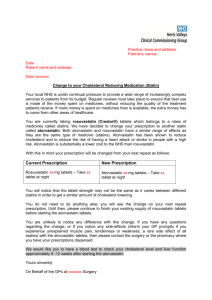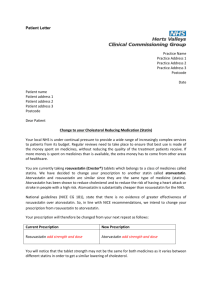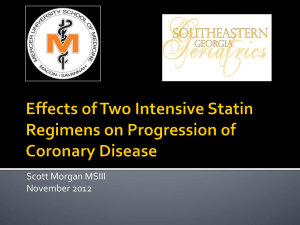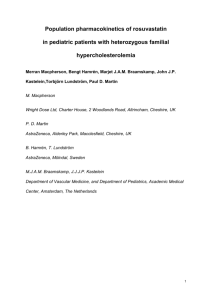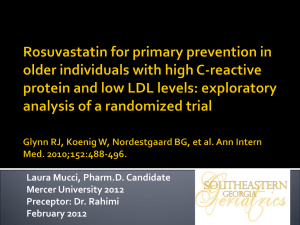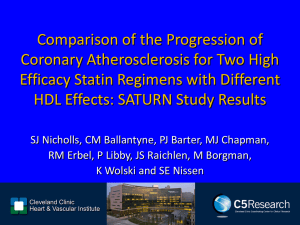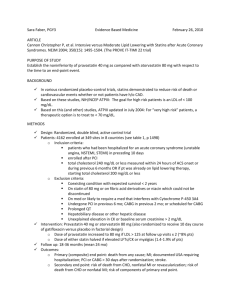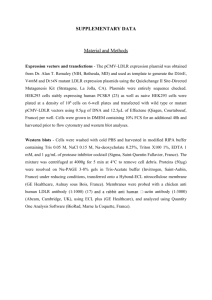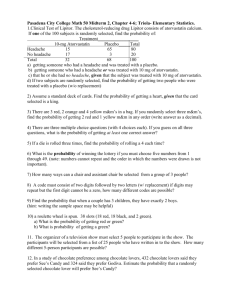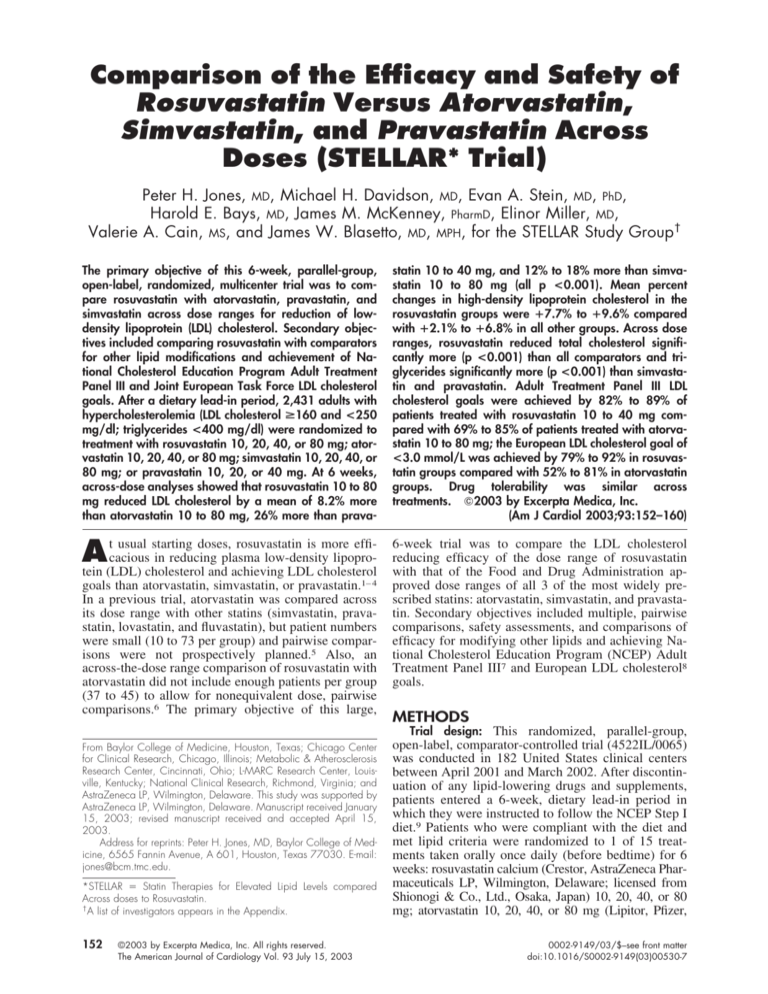
Comparison of the Efficacy and Safety of
Rosuvastatin Versus Atorvastatin,
Simvastatin, and Pravastatin Across
Doses (STELLAR* Trial)
Peter H. Jones, MD, Michael H. Davidson, MD, Evan A. Stein, MD, PhD,
Harold E. Bays, MD, James M. McKenney, PharmD, Elinor Miller, MD,
Valerie A. Cain, MS, and James W. Blasetto, MD, MPH, for the STELLAR Study Group†
The primary objective of this 6-week, parallel-group,
open-label, randomized, multicenter trial was to compare rosuvastatin with atorvastatin, pravastatin, and
simvastatin across dose ranges for reduction of lowdensity lipoprotein (LDL) cholesterol. Secondary objectives included comparing rosuvastatin with comparators
for other lipid modifications and achievement of National Cholesterol Education Program Adult Treatment
Panel III and Joint European Task Force LDL cholesterol
goals. After a dietary lead-in period, 2,431 adults with
hypercholesterolemia (LDL cholesterol >160 and <250
mg/dl; triglycerides <400 mg/dl) were randomized to
treatment with rosuvastatin 10, 20, 40, or 80 mg; atorvastatin 10, 20, 40, or 80 mg; simvastatin 10, 20, 40, or
80 mg; or pravastatin 10, 20, or 40 mg. At 6 weeks,
across-dose analyses showed that rosuvastatin 10 to 80
mg reduced LDL cholesterol by a mean of 8.2% more
than atorvastatin 10 to 80 mg, 26% more than prava-
statin 10 to 40 mg, and 12% to 18% more than simvastatin 10 to 80 mg (all p <0.001). Mean percent
changes in high-density lipoprotein cholesterol in the
rosuvastatin groups were ⴙ7.7% to ⴙ9.6% compared
with ⴙ2.1% to ⴙ6.8% in all other groups. Across dose
ranges, rosuvastatin reduced total cholesterol significantly more (p <0.001) than all comparators and triglycerides significantly more (p <0.001) than simvastatin and pravastatin. Adult Treatment Panel III LDL
cholesterol goals were achieved by 82% to 89% of
patients treated with rosuvastatin 10 to 40 mg compared with 69% to 85% of patients treated with atorvastatin 10 to 80 mg; the European LDL cholesterol goal of
<3.0 mmol/L was achieved by 79% to 92% in rosuvastatin groups compared with 52% to 81% in atorvastatin
groups. Drug tolerability was similar across
treatments. 䊚2003 by Excerpta Medica, Inc.
(Am J Cardiol 2003;93:152–160)
t usual starting doses, rosuvastatin is more efficacious in reducing plasma low-density lipoproA
tein (LDL) cholesterol and achieving LDL cholesterol
6-week trial was to compare the LDL cholesterol
reducing efficacy of the dose range of rosuvastatin
with that of the Food and Drug Administration approved dose ranges of all 3 of the most widely prescribed statins: atorvastatin, simvastatin, and pravastatin. Secondary objectives included multiple, pairwise
comparisons, safety assessments, and comparisons of
efficacy for modifying other lipids and achieving National Cholesterol Education Program (NCEP) Adult
Treatment Panel III7 and European LDL cholesterol8
goals.
goals than atorvastatin, simvastatin, or pravastatin.1– 4
In a previous trial, atorvastatin was compared across
its dose range with other statins (simvastatin, pravastatin, lovastatin, and fluvastatin), but patient numbers
were small (10 to 73 per group) and pairwise comparisons were not prospectively planned.5 Also, an
across-the-dose range comparison of rosuvastatin with
atorvastatin did not include enough patients per group
(37 to 45) to allow for nonequivalent dose, pairwise
comparisons.6 The primary objective of this large,
From Baylor College of Medicine, Houston, Texas; Chicago Center
for Clinical Research, Chicago, Illinois; Metabolic & Atherosclerosis
Research Center, Cincinnati, Ohio; L-MARC Research Center, Louisville, Kentucky; National Clinical Research, Richmond, Virginia; and
AstraZeneca LP, Wilmington, Delaware. This study was supported by
AstraZeneca LP, Wilmington, Delaware. Manuscript received January
15, 2003; revised manuscript received and accepted April 15,
2003.
Address for reprints: Peter H. Jones, MD, Baylor College of Medicine, 6565 Fannin Avenue, A 601, Houston, Texas 77030. E-mail:
jones@bcm.tmc.edu.
*STELLAR ⫽ Statin Therapies for Elevated Lipid Levels compared
Across doses to Rosuvastatin.
†
A list of investigators appears in the Appendix.
152
©2003 by Excerpta Medica, Inc. All rights reserved.
The American Journal of Cardiology Vol. 93 July 15, 2003
METHODS
Trial design: This randomized, parallel-group,
open-label, comparator-controlled trial (4522IL/0065)
was conducted in 182 United States clinical centers
between April 2001 and March 2002. After discontinuation of any lipid-lowering drugs and supplements,
patients entered a 6-week, dietary lead-in period in
which they were instructed to follow the NCEP Step I
diet.9 Patients who were compliant with the diet and
met lipid criteria were randomized to 1 of 15 treatments taken orally once daily (before bedtime) for 6
weeks: rosuvastatin calcium (Crestor, AstraZeneca Pharmaceuticals LP, Wilmington, Delaware; licensed from
Shionogi & Co., Ltd., Osaka, Japan) 10, 20, 40, or 80
mg; atorvastatin 10, 20, 40, or 80 mg (Lipitor, Pfizer,
0002-9149/03/$–see front matter
doi:10.1016/S0002-9149(03)00530-7
New York, New York); simvastatin 10, 20, 40, or 80 mg
(Zocor, Merck & Co, Whitehouse Station, New Jersey);
and pravastatin 10, 20, or 40 mg (Pravachol, BristolMyers Squibb, Princeton, New Jersey). (At the time of
trial initiation, the 80-mg dose of pravastatin was not
approved by the Food and Drug Administration and
therefore was not available for inclusion in this trial.)
Sequential patient numbers were assigned at enrollment
without assumptions about randomization eligibility.
Site-specific randomization schedules were prespecified.
Some patients were initially randomized to 3 cerivastatin
groups, but the protocol and statistical analysis plan were
amended and cerivastatin treatment was discontinued
when cerivastatin was withdrawn from the market (August 2001). The incomplete data from these patients are
not reported here.
Patients: Men and nonpregnant women with hypercholesterolemia who were ⱖ18 years of age were
included in this trial. To be eligible for randomization,
all patients were required to have stable LDL cholesterol concentrations of ⱖ160 and ⬍250 mg/dl at the 2
most recent consecutive visits before randomization.
Lipids were measured at up to 2 additional visits
during the lead-in period if LDL cholesterol levels
were not stable (measurements within 15% of each
other). Triglyceride concentrations were required to
be ⬍400 mg/dl at all prerandomization visits.
Exclusion criteria included a history of sensitivity
to statins; serious or unstable medical or psychological
conditions that could compromise the patient’s safety
or successful trial participation; a history of heterozygous or homozygous familial hypercholesterolemia or
familial dysbetalipoproteinemia; use of concomitant
medications known to affect the lipid profile or
present a potential safety concern; a history of drug or
alcohol abuse; unexplained increases in creatine kinase to ⬎3 times the upper limit of normal during the
dietary lead-in period; alanine aminotransferase
(ALT), aspartate aminotransferase (AST), or bilirubin
values ⱖ1.5 times the upper limit of normal during the
dietary lead-in period; and participation in another
investigational drug trial within 4 weeks of trial
enrollment.
All participants gave informed consent before any
trial procedure was initiated. The relevant institutional
review boards approved the trial protocol and any
amendments, and the trial was performed in accordance with the ethical principles consistent with good
clinical practice.
Measurements and statistical analyses: Blood samples were collected before randomization (ⱖ3 times),
at randomization, and after 4 and 6 weeks of treatment. Patients were instructed to fast and avoid alcohol consumption and cigarette smoking for ⱖ12 hours
before blood collection. All lipid and lipoprotein analyses were performed on plasma samples at a central
laboratory (Medical Research Laboratories International, Highland Heights, Kentucky), which remained
Part III certified by the Centers for Disease Control
(Atlanta, Georgia)/National Heart, Lung, and Blood
Institute (Bethesda, Maryland) throughout the trial.10
High-density lipoprotein (HDL) cholesterol was iso-
lated with heparin-2 manganese chloride.11 LDL cholesterol was calculated by the Friedewald formula,12 if
triglyceride levels were ⬍400 mg/dl, and measured
using preparative ultracentrifugation at d ⫽ 1.006 if
triglycerides were ⬎400 mg/dl.13
The primary end point was percent change in LDL
cholesterol from baseline to 6 weeks. Baseline was the
mean of 3 values (the 2 values obtained at the 2
consecutive visits before randomization and the value
obtained at randomization). All results shown are
from the intention-to-treat population, which included
patients randomized to the relevant treatment groups
who received ⱖ1 dose of drug and had ⱖ1 postbaseline value. The last observation was carried forward if
the patient did not complete 6 weeks of treatment.
Per-protocol analyses that excluded patients who did
not meet entrance criteria, were misrandomized, or
had other major protocol violations or deviations were
done as a robustness check of the primary intentionto-treat analysis.
A 6% difference between treatments in LDL cholesterol reduction was predefined as clinically meaningful.14 Assuming a SD of 12%, and to show this 6%
difference in each of 25 potential comparisons of
interest with a power of 85%, it was estimated that
approximately 150 patients needed to be randomized
to each group to provide data on 141 patients.
To obtain the overall across-dose-range treatment
effects, the average differences between log-dose
slopes for percent changes from baseline in lipids
were obtained for rosuvastatin versus each comparator
in separate analyses. These analyses used an analysis
of covariance model that included terms for treatmentby-log-dose interaction (indicator of dose response
across the dose range), baseline, treatment, log dose,
center, and treatment-by-center interaction. (Log dose
was the log [base 10] of the drug dose in milligrams.)
Then, if the treatment-by-log-dose interaction was not
significant, it was concluded that the log-dose response percent reduction slopes for rosuvastatin and
the comparator were parallel, the treatment-by-logdose term was dropped from the model, and the remaining terms were reestimated. If the treatment effect was significant, it was used to estimate the distance between the dose-response slopes, which is
reported as least-squares mean differences. However,
if the treatment-by-log-dose interaction was significant (i.e., the log-dose slopes of rosuvastatin and the
comparator were not parallel), the difference between
each equivalent dose was analyzed separately with no
adjustments for multiple testing.
In addition to the log-dose comparisons across
dose ranges, selected specific, pairwise comparisons
of interest between rosuvastatin doses and equivalent
or higher doses of comparators were prospectively
planned and performed using analysis of variance. To
present clinically relevant results that would be consistent with proposed labeling at initial drug approval,
22 pairwise comparisons with only rosuvastatin 10,
20, and 40 mg were prospectively planned (before
data availability). These comparisons were as follows:
rosuvastatin 10 mg versus atorvastatin 10, 20, and 40
PREVENTIVE CARDIOLOGY/STATINS COMPARED ACROSS DOSES
153
TABLE 1 Patient Characteristics at Randomization
Women
Men
Age (mean ⫾ SD) (yrs)
Age (range; yrs)
ⱖ65 yrs
White
Black
Hispanic
Other
BMI (mean ⫾ SD)* (kg/m2)
BMI ⬎30 (kg/m2)
Atherosclerosis†
Diabetes mellitus
Rosuvastatin
10–40 mg
(n ⫽ 480)
Rosuvastatin
10–80 mg
(n ⫽ 643)
Atorvastatin
10–80 mg
(n ⫽ 641)
Simvastatin
10–80 mg
(n ⫽ 655)
Pravastatin
10–40 mg
(n ⫽ 492)
249 (52%)
231 (48%)
58 ⫾ 12
21–92
138 (29%)
412 (86%)
37 (8%)
23 (5%)
8 (2%)
29 ⫾ 6
169 (35%)
84 (18%)
38 (8%)
333 (52%)
310 (48%)
57 ⫾ 12
21–92
182 (28%)
553 (86%)
51 (8%)
29 (4%)
10 (2%)
29 ⫾ 6
225 (35%)
114 (18%)
47 (7%)
320 (50%)
321 (50%)
58 ⫾ 12
21–86
197 (31%)
548 (85%)
54 (8%)
22 (3%)
17 (3%)
29 ⫾ 6
228 (36%)
129 (20%)
47 (7%)
333 (51%)
322 (49%)
58 ⫾ 12
22–87
191 (29%)
566 (86%)
51 (8%)
26 (4%)
12 (2%)
29 ⫾ 5
225 (34%)
128 (20%)
47 (7%)
244 (50%)
248 (50%)
57 ⫾ 11
24–85
134 (27%)
420 (85%)
48 (10%)
14 (3%)
10 (2%)
30 ⫾ 5
185 (38%)
88 (18%)
38 (8%)
*Body mass index (BMI) (killograms per square meter) was not calculated for the following numbers of patients: 4 in the rosuvastatin 10- to 40-mg group, 9 in the
rosuvastatin 10- to 80-mg group, 6 in the atorvastatin 10- to 80-mg group, 3 in the simvastatin 10- to 80-mg group, and 2 in the pravastatin 10- to 40-mg group.
†
History of angina, myocardial infarction, cerebrovascular accident, transient ischemic attack, or intermittent claudication, or any documented carotid artery,
peripheral vascular, or coronary artery disease.
mg/dl for patients at lower risk. The
European goal was ⬍116 mg/dl (⬍3
mmol/L) according to the guidelines
of the European Joint Task Force.8
Pairwise comparisons (with the significance level adjusted for multiple
comparisons) of the proportions of
patients who achieved NCEP or European LDL cholesterol goals were
performed with a logistic regression
model that included terms for treatment, baseline, LDL cholesterol, and
risk group.
Safety assessments included reFIGURE 1. Patient disposition. *Numbers in parentheses are the number of patients
cording of treatment-emergent adwho discontinued the study because of adverse events. Other reasons for withdrawal
verse events (adverse events that
in the total patient population were: inclusion criteria not met (4); investigator’s disstarted or worsened during randomcretion (10); lost to follow-up (1); protocol noncompliance (16); withdrawal of consent
(30); and randomized in error (2). A ⴝ atorvastatin; P ⴝ pravastatin; R ⴝ rosuvastaized treatment), hematologic and
tin; S ⴝ simvastatin. Numbers listed with the drugs represent the drug doses (in milliclinical chemistry measurements
grams).
(performed in the same central laboratory), and physical examinations.
Additional monitoring was permg, simvastatin 10, 20, and 40 mg, and pravastatin 10, formed for patients who had creatine kinase values
20, and 40 mg; rosuvastatin 20 mg versus atorvastatin ⬎10 times the upper limit of normal or elevated ALT,
20, 40, and 80 mg, simvastatin 20, 40, and 80 mg, and AST, alkaline phosphatase, or bilirubin values. All
pravastatin 20 and 40 mg; and rosuvastatin 40 mg patients who received any study drug were included in
versus atorvastatin 40 and 80 mg, simvastatin 40 and the safety analysis, and safety data were summarized
80 mg, and pravastatin 40 mg. Differences were sig- descriptively without statistical analysis.
nificant if the p value was ⬍0.002 (using Bonferroni’s
adjustment for multiple comparisons).15 These pair- RESULTS
wise comparisons were repeated for each lipid
Patient characteristics: Baseline patient characterismeasurement.
tics were very similar among groups. Table 1 shows
To determine patients’ NCEP LDL cholesterol characteristics by drug assignment. Of the 2,431 pagoals, patients were classified into risk categories as tients randomized to treatment, 94% completed the
defined by the NCEP Adult Treatment Panel III guide- 6-week trial (Figure 1). Drug compliance as assessed
lines.7 LDL cholesterol goals were ⬍100 mg/dl for by tablet counts was similar among treatments, and
patients with coronary heart disease, coronary heart means of tablets taken ranged from 90.5% to 95.3%.
disease risk equivalents, or multiple risk factors that
Efficacy: According to the dose-response analyses,
conferred a 10-year coronary heart disease risk of mean differences between the LDL cholesterol dose⬎20%; LDL cholesterol goals were ⬍130 and ⬍160 response slopes of rosuvastatin 10 to 80 mg versus
154 THE AMERICAN JOURNAL OF CARDIOLOGY姞
VOL. 93
JULY 15, 2003
FIGURE 2. Least-squares mean (SE) percentage changes from baseline in LDL cholesterol at week 6, and mean differences (SE) across
the dose ranges from the analysis of covariance (versus atorvastatin and pravastatin) and analysis of variance (versus simvastatin)
for (A) rosuvastatin versus atorvastatin (95% confidence interval 6.8% to 9.7%), (B) rosuvastatin versus simvastatin, and (C) rosuvastatin versus pravastatin (95% confidence interval 24.4% to 27.5%). *p <0.001. (The difference across the dose ranges for the rosuvastatin vs simvastatin comparison could not be calculated, because the slopes were nonparallel.)
TABLE 2 Mean (SD) Baseline (BL) and Least-squares Mean Percentage Change from Baseline in LDL Cholesterol
10 mg
n
BL (mean ⫾ SD) (mg/dl)
% Change
p Value (CI)* vs rosuvastatin
20 mg
n
BL (mean ⫾ SD) (mg/dl)
% Change
p Value (CI)* vs rosuvastatin
p Value (CI)* vs rosuvastatin
40 mg
n
BL (mean ⫾ SD) (mg/dl)
% Change
p Value (CI)* vs rosuvastatin
p Value (CI)* vs rosuvastatin
p Value (CI)* vs rosuvastatin
80 mg
n
BL (mean ⫾ SD) (mg/dl)
% Change
p Value (CI)* vs rosuvastatin
p Value (CI)* vs rosuvastatin
Rosuvastatin
Atorvastatin
Simvastatin
Pravastatin
156
188 ⫾ 19
⫺45.8
158
189 ⫾ 18
⫺36.8
⬍0.001 (⫺13.5, ⫺4.7)
165
189 ⫾ 19
⫺28.3
⬍0.001 (⫺22.0, ⫺13.2)
160
189 ⫾ 18
⫺20.1
⬍0.001 (⫺30.1, ⫺21.3)
160
187 ⫾ 18
⫺52.4
155
190 ⫾ 20
⫺42.6
0.026 (⫺7.7, 1.3)
⬍0.001 (⫺14.2, ⫺5.3)
162
189 ⫾ 19
⫺35.0
⬍0.001 (⫺15.2, ⫺6.4)
⬍0.001 (⫺21.7, ⫺13.0)
164
187 ⫾ 17
⫺24.4
⬍0.001 (⫺25.9, ⫺17.1)
⬍0.001 (⫺32.4, ⫺23.7)
157
194 ⫾ 19
⫺55.0
156
189 ⫾ 20
⫺47.8
0.164 (⫺2.4, 6.5)
⬍0.002 (⫺9.0, ⫺0.1)
⬍0.001 (⫺11.6, ⫺2.7)
158
187 ⫾ 16
⫺38.8
⬍0.001 (⫺11.4, ⫺2.6)
⬍0.001 (⫺18.0, ⫺9.1)
⬍0.001 (⫺20.6, ⫺11.7)
161
190 ⫾ 19
⫺29.7
⬍0.001 (⫺20.6, ⫺11.7)
⬍0.001 (⫺27.1, ⫺18.3)
⬍0.001 (⫺29.7, ⫺20.9)
NA
NA
NA
165
190 ⫾ 20
⫺51.1
0.363 (⫺5.6, 3.1)
0.006 (⫺8.3, 0.5)
163
190 ⫾ 19
⫺45.8
⬍0.001 (⫺11.0, ⫺2.2)
⬍0.001 (⫺13.6, ⫺4.8)
NA
NA
NA
10 mg
10 mg
20 mg
10 mg
20 mg
40 mg
20 mg
40 mg
Results of statistical analyses of 22 comparisons of percentage changes versus rosuvastatin 10, 20, and 40 mg are also shown.
*p Value and 99.8% confidence intervals (CI) for the difference between rosuvastatin and the comparator from an analysis of variance. p values ⬍0.002 are
statistically significant.
atorvastatin 10 to 80 mg and pravastatin 10 to 40 mg
were significant (both p ⬍0.001) (Figure 2). The logdose slopes of rosuvastatin and simvastatin were not
parallel, but equivalent doses were significantly different (Figure 2). All differences that were ⬎6% were
considered clinically significant.
In the pairwise, dose-to-dose comparisons with
atorvastatin, rosuvastatin 10 mg reduced LDL cholesterol significantly more than atorvastatin 10 mg, rosuvastatin 20 mg reduced LDL cholesterol significantly
more than atorvastatin 20 and 40 mg, and rosuvastatin
40 mg reduced LDL cholesterol significantly more
than atorvastatin 40 mg (Table 2). In all but 1 of the
other pairwise comparisons with atorvastatin (rosuvastatin 10 vs atorvastatin 40 mg), rosuvastatin produced numerically greater LDL cholesterol reductions, but these differences were not significantly different (Table 2). Rosuvastatin reduced LDL
cholesterol significantly more than simvastatin and
pravastatin in all 14 pairwise comparisons analyzed
(Table 2). The best LDL cholesterol reduction (55%)
was achieved in the rosuvastatin 40-mg group and was
not significantly different (p ⫽ 0.006) from the next
highest LDL cholesterol reduction (51%) observed in
the atorvastatin 80-mg group.
Rosuvastatin 40 mg had the most effect and ator-
PREVENTIVE CARDIOLOGY/STATINS COMPARED ACROSS DOSES
155
FIGURE 3. Least-squares mean (SE) percentage changes from baseline in HDL cholesterol at week 6 across dose ranges, and mean
differences (SE) from analysis of variance (versus atorvastatin) or covariance (versus simvastatin and pravastatin) for (A) rosuvastatin
versus atorvastatin for equivalent doses (the difference across the dose range for the rosuvastatin vs atorvastatin comparison could
not be calculated, because the slopes were nonparallel), (B) rosuvastatin versus simvastatin, and (C) rosuvastatin versus pravastatin.
*p <0.001.
vastatin 80 mg had the least effect on HDL cholesterol
(Figure 3). Across dose ranges, the HDL cholesterol
increasing effect of rosuvastatin was consistent across
the dose range in contrast to atorvastatin and was
significantly higher (p ⬍0.001) compared with simvastatin and pravastatin (Figure 3). The log-dose analysis across dose ranges showed that rosuvastatin 10 to
80 mg reduced total cholesterol 4.7% more than atorvastatin 10 to 80 mg and 18.7% more than pravastatin
10 to 40 mg (both p ⬍0.001) (data not shown). The
log-dose slopes of rosuvastatin 10 to 80 mg and simvastatin 10 to 80 mg were not parallel, and differences
ranged from 9.0% (80-mg doses) to 12.5% (10-mg
doses). Across the dose ranges, rosuvastatin 10 to 80
mg reduced triglycerides 7.5% more than simvastatin
and 13.1% more than pravastatin (both p ⬍0.001), but
the log-dose slopes for triglyceride reductions were
not different between rosuvastatin and atorvastatin
(data not shown). Pairwise comparisons among
groups for HDL cholesterol, total cholesterol, and
triglycerides are shown in Table 3.
The per-protocol analyses included 122 to 138
patients per group. The results from these analyses
were consistent with those obtained in the intentionto-treat analyses and supported the conclusions based
on the primary analyses.
In this analysis, the highest proportions of patients
(89%) who met NCEP LDL cholesterol goals were in
the rosuvastatin 20- and 40-mg groups (Figure 4). The
percentage of patients who reached NCEP LDL cholesterol goals in the rosuvastatin 10-mg group (82%)
was similar to the highest percentages in the atorvastatin and simvastatin groups (85% and 82%, respectively). Overall, 29% of these patients had goals of
⬍100 mg/dl. Also, the highest percentages of patients
reaching the European goal of ⬍116 mg/dl (⬍3.0
mmol/L) were in the rosuvastatin 20- and 40-mg
groups (92% and 91%, respectively) (Figure 5). The
percentage of patients (79%) who reached this goal
with rosuvastatin 10 mg was similar to the percentage
156 THE AMERICAN JOURNAL OF CARDIOLOGY姞
VOL. 93
who reached this goal with the highest doses of atorvastatin and simvastatin (81% and 77%, respectively).
Safety: Overall, trial treatments were well tolerated.
The percentages of patients who reported adverse
events during randomized treatment were similar
among groups and ranged from 40% to 56% per group
and were 46% in the total study population. The
percentages of patients who withdrew from treatment
because of adverse events were also similar among
groups (Figure 1). Twenty-nine patients had serious
adverse events; the number per group ranged from 0
(rosuvastatin 40-mg group) to 5 (simvastatin 40-mg
group). Two of these patients with serious adverse
events died (1 who received simvastatin 10 mg and 1
who received atorvastatin 40 mg) from causes unrelated to treatment (cardiovascular disease). Two patients in the rosuvastatin 80-mg group developed acute
renal failure of uncertain etiology. One of them required a short interval of dialysis, and both patients
recovered after discontinuation of medications.
The other adverse events reported were generally
mild and similar across groups. The most common
adverse events were pain, pharyngitis, myalgia, and
headache, which were reported by 6%, 5%, 4%, and
3%, respectively, of overall patients. The highest
number (⬎5%) of patients reporting myalgia were in
the groups receiving rosuvastatin 80 mg (7.3%), atorvastatin 20 mg (6.4%), atorvastatin 80 mg (5.4%), or
pravastatin 20 mg (5.4%). The lowest numbers (⬍2%)
of patients reporting myalgia were in the rosuvastatin
40-mg and simvastatin 40-mg groups.
Changes in clinical laboratory results were generally small. Five patients (atorvastatin 80 mg, 2 patients; atorvastatin 20 mg, 1 patient; simvastatin 40
mg, 1 patient; and simvastatin 80 mg, 1 patient) had
clinically important ALT elevations (⬎3 times the
upper limit of normal at 2 consecutive visits). No
cases of myopathy (creatine kinase ⬎10 times the
upper limit of normal with associated muscle symptoms) were observed. Three patients (rosuvastatin 80
JULY 15, 2003
TABLE 3 Mean ⫾ SD Baseline (BL) and Least-squares Mean Percentage Changes from BL in HDL Cholesterol, Triglycerides, and
Total Cholesterol
HDL
10 mg
BL (mean ⫾ SD) (mg/dl)
% Change
20 mg
BL (mean ⫾ SD) (mg/dl)
% Change
40 mg
BL (mean ⫾ SD) (mg/dl)
% change
80 mg
BL (mean ⫾ SD) (mg/dl)
% Change
Triglycerides
10 mg
BL (mean ⫾ SD) (mg/dl)
% Change
20 mg
BL (mean ⫾ SD) (mg/dl)
% Change
40 mg
BL (mean ⫾ SD) (mg/dl)
% Change
80 mg
BL (mean ⫾ SD) (mg/dl)
% Change
Total cholesterol
10 mg
BL (mean ⫾ SD) (mg/dl)
% Change
20 mg
BL (mean ⫾ SD) (mg/dl)
% Change
40 mg
BL (mean ⫾ SD) (mg/dl)
% Change
80 mg
BL (mean ⫾ SD), mg/dl
% Change
Rosuvastatin
Atorvastatin
Simvastatin
Pravastatin
51 ⫾ 11
⫹7.7
50 ⫾ 12
⫹5.7
51 ⫾ 12
⫹5.3
50 ⫾ 13
⫹3.2*
51 ⫾ 11
⫹9.5
50 ⫾ 12
⫹4.8†
50 ⫾ 12
⫹6.0
49 ⫾ 11
⫹4.4†
50 ⫾ 12
⫹9.6
50 ⫾ 11
⫹4.4†‡
51 ⫾ 11
⫹5.2†‡
50 ⫾ 10
⫹5.6†‡
NA
NA
51 ⫾ 13
⫹2.1†‡
51 ⫾ 12
⫹6.8
NA
NA
179 ⫾ 62
⫺19.8
174 ⫾ 59
⫺20.0
174 ⫾ 59
⫺11.9
187 ⫾ 63
⫺8.2*
180 ⫾ 72
⫺23.7
176 ⫾ 64
⫺22.6
182 ⫾ 65
⫺17.6
179 ⫾ 67
⫺7.7*†
183 ⫾ 59
⫺26.1
178 ⫾ 64
⫺26.8
172 ⫾ 61
⫺14.8†‡
181 ⫾ 63
⫺13.2†‡
NA
NA
181 ⫾ 66
⫺28.2
178 ⫾ 64
⫺18.2
NA
NA
275 ⫾ 23
⫺32.9
274 ⫾ 24
⫺27.1*
275 ⫾ 24
⫺20.3*
276 ⫾ 24
⫺14.7*
274 ⫾ 24
⫺37.6
275 ⫾ 27
⫺31.8†
276 ⫾ 24
⫺25.7*†
271 ⫾ 21
⫺17.2*†
280 ⫾ 22
⫺40.2
275 ⫾ 25
⫺35.8‡
272 ⫾ 23
⫺27.9*†‡
276 ⫾ 24
⫺21.5*†‡
NA
NA
279 ⫾ 26
⫺38.9
277 ⫾ 24
⫺32.9†‡
NA
NA
Pairwise comparisons were performed between rosuvastatin 10 mg and atorvastatin 10, 20, and 40 mg, simvastatin 10, 20, and 40 mg, and pravastatin 10, 20,
and 40 mg; between rosuvastatin 20 mg and atorvastatin 20, 40, and 80 mg, simvastatin 20, 40, and 80 mg, and pravastatin 20 and 40 mg; and between
rosuvastatin 40 mg and atorvastatin 40 and 80 mg, simvastatin 40 and 80 mg, and pravastatin 40 mg.
*Significantly different versus rosuvastatin 10 mg; †significantly different versus rosuvastatin 20 mg; ‡significantly different versus rosuvastatin 40 mg (p values
⬍0.002 are statistically significant).
mg, 1 patient; and simvastatin 10 mg, 2 patients) had
a clinically important elevation (⬎10 times the upper
limit of normal) of creatine kinase, without associated
muscle-related symptoms.
DISCUSSION
This multicenter trial, which is the largest trial of
its kind to date comparing the lipid-modifying efficacy
of statins, showed the greater efficacy of rosuvastatin
in reducing LDL cholesterol, compared with atorvastatin, simvastatin, and pravastatin across dose ranges.
The significantly greater LDL cholesterol reduction
achieved with rosuvastatin 10 to 80 mg, compared
with atorvastatin 10 to 80 mg, which was an average
difference of 8.2% across the dose-range slopes, exceeded the predefined clinically meaningful difference
of 6% and was similar to the 8.4% greater reduction
observed by Schneck et al.6 Also, the greater LDL
cholesterol reductions achieved across dose ranges
with rosuvastatin than with simvastatin and pravastatin confirmed the relative differences in the LDL cholesterol reducing efficacy of these statins, which has
been previously shown.3–5 Pairwise comparisons in
this trial showed that a dose of the comparators that
was 2 or 4 times higher than rosuvastatin 10 and 20
mg did not result in significantly greater LDL cholesterol reductions. These greater LDL cholesterol reductions with rosuvastatin than with the comparators resulted in a higher percentage of patients who achieved
their NCEP and European LDL cholesterol goals.
Importantly, rosuvastatin can achieve most of these
lipid-modifying benefits at a dose of 10 mg/day.
As rosuvastatin doses increased to 40 mg, HDL
PREVENTIVE CARDIOLOGY/STATINS COMPARED ACROSS DOSES
157
FIGURE 4. Percentages of patients who met LDL cholesterol NCEP’s Adult Treatment
Panel III goals at the end of treatment, and results of logistic regression analyses for 22
comparisons versus (A) rosuvastatin 10 mg, (B) rosuvastatin 20 mg, and (C) rosuvastatin
40 mg. (p values <0.002 are statistically significant.)
FIGURE 5. Percentages of patients who had LDL cholesterol values below the European
goal of 116 mg/dl (3.0 mmol/L) at the end of treatment, and results of logistic regression analyses for 22 comparisons versus (A) rosuvastatin 10 mg, (B) rosuvastatin 20
mg, and (C) rosuvastatin 40 mg. (p values <0.002 are statistically significant.).
158 THE AMERICAN JOURNAL OF CARDIOLOGY姞
VOL. 93
JULY 15, 2003
cholesterol changes from baseline
were increased, in contrast with
atorvastatin, which produced
lesser percentage increases in HDL
cholesterol levels with increased
doses. This attenuation of the increase in HDL cholesterol levels
with higher doses of atorvastatin
has been shown previously in other
well-controlled, randomized, double-blind trials.5,6,16 When rosuvastatin was compared across the
dose ranges with simvastatin or
pravastatin, the log-dose slopes
were parallel, and HDL cholesterol
was increased significantly more
with rosuvastatin. Rosuvastatin
also produced significantly better
reductions in total cholesterol and
similar or significantly better reductions in triglycerides, compared with atorvastatin, simvastatin, and pravastatin.
Because of the open-label design, patients’ reporting of adverse
events could have been affected by
their awareness of their drug treatment or expectations from previous experiences with statin drugs.
However, the numbers and nature
of adverse events were generally
consistent with those observed in
previous double-blind trials2,3,17
and not different among drug treatments. The number of reported adverse events tended to be highest
with higher doses. Likewise, although a few patients had elevated
transaminase and creatine kinase
levels, laboratory value results
were generally similar among the
groups, and no cases of myopathy
were observed.
Although the trial treatments
were administered in an open-label
manner, the laboratory analyses
and data analyses were blinded to
patients and investigators, thereby
removing analysis bias. Furthermore, the potential for randomization bias was minimized by the
assignment of sequential numbers
to patients at enrollment before
trial eligibility was determined and
the use of a prespecified randomization schedule that took the
choice of treatment away from the
investigator.
The 6-week study period was
shorter than in most previous studies of statin efficacy2,3,5,18; however, it is well established that sta-
tins exhibit most of their LDL cholesterol reducing
effects within 2 weeks and produce full effects by 4 to
6 weeks.2,3 Therefore, 6 weeks was considered an
adequate time to show the relative LDL cholesterol
reducing efficacy of the statins studied.
A strength of this trial was the absence of an upper
age limit for participants, which resulted in the inclusion of many patients in older age categories. The
most important strength of this trial was the study
design, which included many patients per treatment
group and the prospectively determined ability to
make multiple comparisons across doses in a statistically valid manner. Because a greater number of analyses increase the chances that a significant difference
will be found among groups, the number of pairwise
comparisons was limited to those comparisons of most
interest. The use of the Bonferroni adjustment of the
significance level resulted in a conservative interpretation and increased the confidence in the results.
Acknowledgment: We gratefully acknowledge the
investigators (see Appendix), their coinvestigators and
study coordinators, and the patients who participated
in this trial. In addition, we wish to thank Marlies
Winter, MS, and Jackie Freimor, MA, of BioScience
Communications, and Donna Curtis, PhD, and Erem
Latif, MS, of AstraZeneca LP (Wilmington, Delaware), for their assistance in the preparation of this
manuscript.
NC; Irving Loh, MD, Thousand Oaks, CA; Barry Lubin, MD, Norfolk, VA;
Norman Lunde, MD, Arden Hills, MN; Frank Maggiacomo, DO, Cranston, RI;
Michael McCartney, MD, Salisbury, MA; Mark McClanahan, MD, Fredericksburg, VA; Thomas F. McGarry, MD, Oklahoma City, OK; Robert McGhee, DO,
Ocala, FL; Mary McGowan, MD, Manchester, NH; John McLean, MD, Salisbury, MD; Leslie Mezei, MD, St. Louis, MO; Alan Miller, MD, Dunwoody, GA;
Michael Miller, MD, Baltimore, MD; David Morin, MD, Britsol, TN; Jeffrey
Morton, MD, Peoria, IL; David S. Moss, MD, Charlotte, NC; Puneet Narayan,
MD, Springfield, VA; Stephen D. Nash, MD, Syracuse, NY; Joel Neutel, MD,
Orange, CA; Thomas Nolen, MD, Columbiana, AL; Ruth Nurnberg, MD, Richmond, VA; Thomas O’Barr, MD, Marietta, GA; Joseph O’Bryan, MD, Fort
Myers, FL; Charles A. Ogles, MD, Eclectic, AL; David N. Pate, MD, Mobile,
AL; Naynesh Patel, MD, Kettering, OH; Richard Pellegrino, MD, Hot Springs,
AR; David Perloff, MD, Ft. Lauderdale, FL; Frank Pettyjohn, MD, Mobile, AL;
Daniel Phillips, MD, Pensacola, FL; David Podlecki, MD, Longmont, CO;
Walter Powell, MD, Newark, DE; Anthony Puopolo, MD, Milford, MA; Joshua
Rassen, MD, San Francisco, CA; Marc Rendell, MD, Omaha, NE; Jim Rhyne,
MD, Statesville, NC; Stephen Richardson, MD, New York, NY; James Rippe,
MD, Shrewsbury, MA; David Robertson, MD, Atlanta, GA; Frederick Robinson,
MD, Ninety Six, SC; Jeff Rosen, MD, Coral Gables, FL; Robert Rosenson, MD,
Chicago, IL; Julio Rosenstock, MD, Dallas, TX; Douglas Rosing, MD, Bethesda,
MD; John Rubino, MD, Raleigh, NC; Joseph Saponaro, MD, Jupiter, FL; Helmut
Schrott, MD, Iowa City, IA; Sherwyn L. Schwartz, MD, San Antonio, TX; Louis
Shane, MD, White Plains, NY; Diane K. Smith, MD, Augusta, GA; Lynn Smith,
MD, Lewisburg, WV; Timothy Smith, MD, Chesterfield, MO; Norman Soler,
MD, Springfield, IL; Eric Solomon, MD, Pelham, AL; Gerald Sotsky, MD,
Ridgewood, NJ; Joseph Soufer, MD, Waterbury, CT; Dennis Sprecher, MD,
Cleveland, OH; Jeffrey Steinberg, MD, Hollywoode, FL; Vashu Thakur, MD,
New Orleans, LA; Melvin Tonkon, MD, Santa Ana, CA; Andrew Torkelson, MD,
Lebanon, NH; Phillip D. Toth, MD, Indianapolis, IN; Martin Van Cleeff, MD,
Cary, NC; David VandeMerwe, MD, Salt Lake City, UT; Daniel Van Hamersveld, MD, Sacramento, CA; David Van Sickle, MD, Tualatin, OR; Ralph Vicari,
MD, Melbourne, FL; Krishnaswami Vijayaraghava, MD, Phoenix, AZ; Augusto,
Villa, MD, Palm Beach Gardens, FL; Jennifer Wahle, MD, Evansville, IN;
Richard Wasnich, MD, Honolulu, HI; Mervyn Weerasinghe, MD, Rochester,
NY; Marc Weinberg, MD, Providence, RI; Richard Weinstein, MD, Walnut
Creek, CA; Gilbert Weisman, DO, Warminster, PA; Robert Weiss, MD, Auburn,
ME; Jeffrey Whitmer, MD, PhD, Cincinnati, OH; Frederick Whittier, MD,
Canton, OH: William Wickmeyer, MD, Canton, OH; William Wingfield, MD,
Charleston, SC; Duane Wombolt, MD, Norfolk, VA; Donald Wood, MD, Salisbury, MD; Lawrence Yellen, MD, San Diego, CA; James Zavoral, MD, Edina,
MN; Ayman Zayed, MD, Anniston, AL.
APPENDIX
In addition to the authors of this publication, the following investigators
participated in this trial: Angeli Adamczyk, MD, Tucson, AZ; Peter Alagona,
MD, Tampa, FL; Robert Anderson, MD, Omaha, NE; Luis Angeles, MD,
Shawnee Mission, KS; Maurice Archuleta, MD, Golden, CO; David Axline, MD,
Naples, FL; Robert Bettis, MD, Edmonds, WA; Brian T. Bock, DO, Harleysville,
PA; Michael Bolognese, MD, Bethesda, MD; Eric Bolster, MD, Summerville,
SC; Jonathan Bortz, MD, Richmond Heights, MD; Verdayne Brandenburg, MD,
Sioux Falls, SD; Donald Brideau, MD, Alexandria, VA; Osvaldo A. Brusco, MD,
Corpus Christi, TX; Arthur Bucci, MD, Pittsburgh, PA; David Calhoun, MD,
Birmingham, AL; Maria Canossa-Terris, MD, Miami Beach, FL; David Capuzzi,
MD, Philadelphia, PA; Christopher Chappel, MD, Kissimmee, FL; Brett Cohen,
MD, Trumbull, CT; Harry Collins, MD, S. Plainfield, NJ; Martin Conway, MD,
Albuquerque, NM; Brian Cospolich, MD, Marrero, LA; Gary Dalley, MD,
Gainsville, GA; Michael Davidson, MD, Chicago, IL; Prakash Deedwania, MD,
Fresno, CA; Michael Devine, MD, Canfield, OH; Kenneth Dim, MD, Long
Beach, CA; Robert Doroghazi, MD, Columbia, MO; Margaret Drehobl, MD, San
Diego, CA; John Earl, MD, Hickory, NC; Victor Elinoff, MD, Endwell, NY;
Bassem El-Masri, MD, New York, NY; John Ervin, MD, Kansas City, MO;
Lawrence Feld, MD, Mesa, AZ; Robert Feldman, MD, Miami, FL; Keith Ferdinand, MD, New Orleans, LA; Robert Fishberg, MD, Springfield, NJ; Chester
Fisher, MD, Newport News, VA; David Fitz-Patrick, MD, Honolulu, HI; Charles
Fogarty, MD, Spartanburg, SC; Robert Foster, MD, Birmingham, AL; Richard
Galloway, MD, Hattiesburg, MS; Raul Gaona, MD, San Antonio, TX; Jalal
Ghali, MD, Shreveport, LA; Larry Gilderman, DO, Pembroke Pines, FL; Santosh
Gill, MD, Aurora, IL; Geoffrey Gladstein, MD, Stamford, CT; Ronald Graf, MD,
Tacoma, WA; Russell Graham, MD, Altamonte Springs, FL; Richard Guynes,
MD, Jackson, MS; Terrence Hack, MD, Ayer, MA: James Hampsey, MD,
Clearwater, FL; Charles Herring, MD, Wilmington, NC; Richard Heuser, MD,
Phoenix, AZ; Barry Horowitz, MD, West Palm Beach, FL; Timothy Howard,
MD, Huntsville, AL; Richard Hui, MD, Belleville, IL; Donald Hunninghake,
MD, Minneapolis, MN; Joseph Hunter, MD, Southaven, TN; Samuel Idarraga,
MD, Milwaukee, WI; Bruce Iteld, MD, Chalmette, LA; Adesh Jain, MD, Slidell,
LA; Alton James, MD, Mobile, AL; Leonard Keilson, MD, Portland, ME; Dean
Kereiakes, MD, Cincinnati, OH; Boris Kerzner, MD, Baltimore, MD; Dana
Keys-Frezzell, MD, Monessan, PA; Leslie Klaff, MD, Renton, WA; Keith Klatt,
MD, Portland, OR; Michael Koren, MD, Jacksonville, FL; Robert Lang, MD,
Hamden, CT; Kenneth Lasseter, MD, Miami, FL; Gilbert Ledesma, MD, Arlington, TX; Robert Lees, MD, Cambridge, MA; Raphael Levine, MD, Decatur, GA;
Richard Levy, MD, San Francisco, CA; Sandra Lewis, MD, Portland, OR; Eric
Lieberman, MD, Boynton Beach, FL; MacRae Linton, MD, Nashville, TN;
Robert Lipetz, DO, Spring Valley, CA; Thomas Littlejohn, MD, Winston Salem,
1. Davidson M, Ma P, Stein EA, Gotto AM Jr, Raza A, Chitra R, Hutchinson H.
Comparison of effects on low-density lipoprotein cholesterol and high-density
lipoprotein cholesterol with rosuvastatin versus atorvastatin in patients with type
IIa or IIb hypercholesterolemia. Am J Cardiol 2002;89:268 –275.
2. Olsson AG, Istad H, Luurila O, Ose L, Stender S, Tuomilehto J, Wiklund O,
Southworth H, Pears J, Wilpshaar JW, on behalf of the Rosuvastatin Investigators
Group. Effects of rosuvastatin and atorvastatin compared over 52 weeks of
treatment in patients with hypercholesterolemia. Am Heart J 2002;144:1044 –
1051.
3. Brown WV, Bays HE, Hassman DR, McKenney J, Chitra R, Hutchinson H,
Miller E, for the Rosuvastatin Study Group. Efficacy and safety of rosuvastatin
compared with pravastatin and simvastatin in patients with hypercholesterolemia: a randomized, double-blind, 52-week trial. Am Heart J 2002;144:1036 –
1043.
4. Paoletti R, Fahmy M, Mahla G, Mizan J, Southworth H. Rosuvastatin demonstrates greater reduction of low-density lipoprotein cholesterol compared with
pravastatin and simvastatin in hypercholesterolaemic patients: a randomized,
double-blind study. J Cardiovasc Risk 2001;8:383–390.
5. Jones P, Kafonek S, Laurora I, Hunninghake D, for the CURVES Investigators.
Comparative dose efficacy study of atorvastatin versus simvastatin, pravastatin,
lovastatin, and fluvastatin in patients with hypercholesterolemia (the CURVES
study). Am J Cardiol 1998;81:582–587.
6. Schneck DW, Knopp RH, Ballantyne CM, McPherson R, Chitra RR, Simonson
SG. Comparative effects of rosuvastatin and atorvastatin across their dose ranges
in patients with hypercholesterolemia and without active arterial disease. Am J
Cardiol 2003;91:33–41.
7. NCEP Expert Panel. Third Report of National Cholesterol Education Program
(NCER) Expert Panel on detection, evaluation, and treatment of high blood
cholesterol in adults (Adult Treatment Panel III). Final Report. Circulation
2002;106:3143–3421.
8. Wood D, De Backer G, Faergeman O, Graham I, Mancia G, Pyorola K.
Prevention of coronary heart disease in clinical practice. Recommendations of the
Second Joint Task Force of European and Other Societies on Coronary Prevention. Eur Heart J 1998;19:1434 –1503.
9. Remmell PS, Gorder DD, Hall Y, Tillotson JL. Assessing dietary adherence in
the Multiple Risk Factor Intervention Trial (MRFIT). I. Use of a dietary monitoring tool. J Am Diet Assoc 1980;76:351–356.
PREVENTIVE CARDIOLOGY/STATINS COMPARED ACROSS DOSES
159
10. Myers GL, Cooper GR, Winn CL, Smith SJ. The Centers for Disease
Control–National Heart, Lung, and Blood Institute Lipid Standardization Program: an approach to accurate and precise lipid measurements. Clin Lab Med
1989;9:105–135.
11. Warnick G, Albers J. A comprehensive evaluation of the heparin-manganese
precipitation procedure for estimating high-density lipoprotein cholesterol. J
Lipid Res 1978;19:65–76.
12. Friedewald WT, Levy RI, Frederickson DS. Estimation of concentration of
low density lipoprotein cholesterol in plasma, without the use of the preparative
ultracentrifuge. Clin Chem 1972;18:499 –502.
13. Lipid Research Clinics Program. Manual of Operations: Lipid and Lipoprotein Analysis. Washington, DC: US Department of Health, Education, and
Welfare. Publication no. NIH 75-628, 1982.
14. Knopp RH. Drug treatment of lipid disorders. N Engl J Med 1999;341:498 –
511.
160 THE AMERICAN JOURNAL OF CARDIOLOGY姞
VOL. 93
15. Miller RG Jr. Simultaneous Statistical Inference. 2nd Ed. New York, NY:
Springer-Verlag, 1981.
16. Illingworth DR, Crouse JR III, Hunninghake DB, Davidson MH, Escobar ID,
Stalenhoef AF, Paragh G, Ma PT, Liu M, et al, for the Simvastatin Atorvastatin
HDL Study Group. A comparison of simvastatin and atorvastatin up to maximal
recommended doses in a large multicenter randomized clinical trial. Curr Med
Res Opin 2001;17:43–50.
17. Olsson AG, Pears J, McKellar J, Mizan J, Raza A. Effect of rosuvastatin on
low-density lipoprotein cholesterol in patients with hypercholesterolemia. Am J
Cardiol 2001;88:504 –508.
18. Hunninghake D, Bakker-Arkema RG, Wigand JP, Drehobl M, Schrott H,
Early JL, Abdallah P, McBride S, Black DM. Treating to meet NCEP-recommended LDL cholesterol concentrations with atorvastatin, fluvastatin, lovastatin,
or simvastatin in patients with risk factors for coronary heart disease. J Fam Pract
1998;47:349 –356.
JULY 15, 2003

